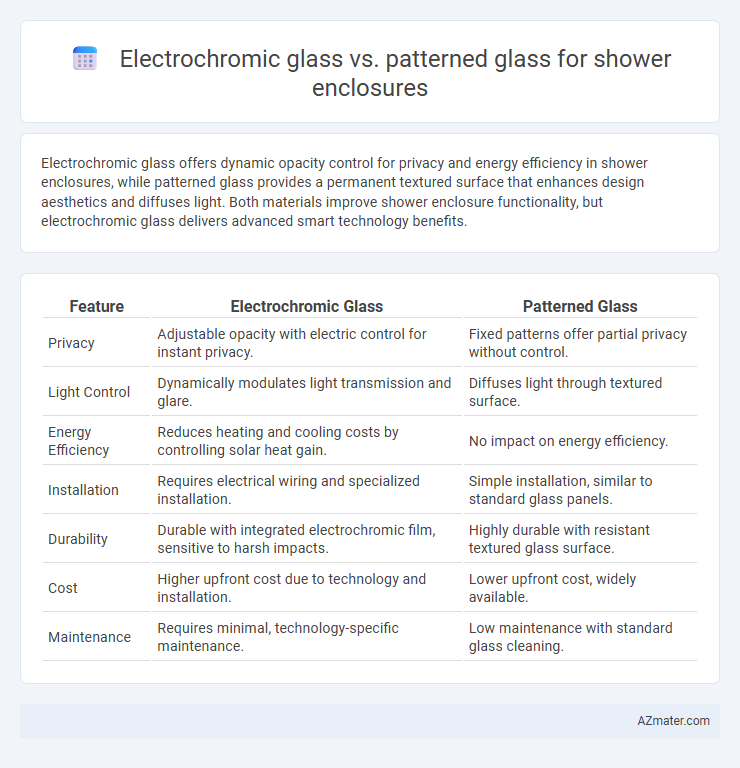Electrochromic glass offers dynamic opacity control for privacy and energy efficiency in shower enclosures, while patterned glass provides a permanent textured surface that enhances design aesthetics and diffuses light. Both materials improve shower enclosure functionality, but electrochromic glass delivers advanced smart technology benefits.
Table of Comparison
| Feature | Electrochromic Glass | Patterned Glass |
|---|---|---|
| Privacy | Adjustable opacity with electric control for instant privacy. | Fixed patterns offer partial privacy without control. |
| Light Control | Dynamically modulates light transmission and glare. | Diffuses light through textured surface. |
| Energy Efficiency | Reduces heating and cooling costs by controlling solar heat gain. | No impact on energy efficiency. |
| Installation | Requires electrical wiring and specialized installation. | Simple installation, similar to standard glass panels. |
| Durability | Durable with integrated electrochromic film, sensitive to harsh impacts. | Highly durable with resistant textured glass surface. |
| Cost | Higher upfront cost due to technology and installation. | Lower upfront cost, widely available. |
| Maintenance | Requires minimal, technology-specific maintenance. | Low maintenance with standard glass cleaning. |
Introduction to Modern Shower Enclosures
Modern shower enclosures increasingly feature advanced materials such as electrochromic glass and patterned glass to enhance privacy and style. Electrochromic glass offers adjustable transparency through electric control, providing customizable privacy and light modulation. Patterned glass, with its textured surfaces, diffuses light while maintaining a decorative element, making it a popular choice for combining functionality with aesthetic appeal in contemporary bathroom designs.
What is Electrochromic Glass?
Electrochromic glass is a smart glass technology that changes its transparency or opacity when an electric voltage is applied, allowing users to control privacy and natural light without the need for curtains or blinds. It consists of multiple layers including an electrochromic layer, conductive coatings, and glass substrates, enabling rapid transition between clear and tinted states. This glass is ideal for shower enclosures, providing customizable privacy and modern aesthetics compared to patterned glass, which relies on fixed textures or designs for obscurity.
What is Patterned Glass?
Patterned glass is a type of decorative glass featuring textured or embossed designs that provide privacy while allowing light to pass through, making it ideal for shower enclosures. Unlike electrochromic glass, which changes opacity with an electrical signal, patterned glass relies on its surface texture to obscure visibility without electronic components. This makes patterned glass a cost-effective and durable option for enhancing both privacy and aesthetic appeal in bathroom spaces.
Visual Privacy: Electrochromic vs Patterned Glass
Electrochromic glass offers dynamic visual privacy by shifting from transparent to opaque at the touch of a button, allowing customizable privacy levels in shower enclosures. Patterned glass provides consistent, static privacy through etched or embossed designs that obscure visibility while adding decorative appeal. Electrochromic glass outperforms patterned glass in adaptability, granting users control over light transmission and privacy on demand.
Technology and Functionality Comparison
Electrochromic glass utilizes smart technology to change transparency on demand, offering adjustable privacy and energy efficiency by blocking UV rays and reducing heat transfer. Patterned glass relies on textured designs etched or molded onto its surface to diffuse light and provide static privacy without altering transparency. The electrochromic option enables dynamic control and enhanced user experience, while patterned glass offers cost-effective, permanent decorative solutions for shower enclosures.
Aesthetics and Design Flexibility
Electrochromic glass offers dynamic opacity control, allowing users to switch between clear and frosted states, enhancing privacy while maintaining a sleek, modern aesthetic ideal for minimalist shower enclosures. Patterned glass features fixed decorative textures or designs that diffuse light and provide consistent privacy, offering a variety of stylistic options such as frosted or etched patterns to complement traditional or contemporary bathroom themes. The design flexibility of electrochromic glass lies in its ability to adapt appearance on demand, whereas patterned glass provides permanent visual interest through diverse textures and patterns.
Durability and Maintenance
Electrochromic glass for shower enclosures offers high durability with scratch-resistant coatings and sealed technology that prevents moisture ingress, reducing the risk of damage over time. Patterned glass, while aesthetically versatile, may accumulate residue in textured surfaces, requiring more frequent and careful maintenance to avoid buildup and discoloration. Both types are engineered for bathroom environments, but electrochromic glass generally demands less upkeep due to its smooth, non-porous surface and advanced protective layers.
Installation Process and Compatibility
Electrochromic glass installation requires specialized wiring and a power source to enable its smart tinting functionality, often involving integration with electrical systems, which may extend installation times compared to patterned glass. Patterned glass is typically simpler to install, as it functions purely as a decorative or privacy surface without electrical components, making it compatible with standard shower enclosure frameworks. Compatibility for electrochromic glass depends on access to power and control systems, while patterned glass fits seamlessly with a wider range of shower enclosure materials and designs due to its non-electrical nature.
Cost Analysis: Upfront and Long-term
Electrochromic glass for shower enclosures carries a significantly higher upfront cost, typically ranging from $150 to $300 per square foot due to the advanced technology and electrical components involved. Patterned glass offers a more budget-friendly initial investment, generally priced between $50 and $100 per square foot, making it attractive for cost-conscious projects. Over the long term, electrochromic glass may lead to energy savings through enhanced privacy and lighting control, while patterned glass incurs minimal maintenance expenses but lacks the dynamic functionality, influencing overall lifecycle cost considerations.
Which Glass is Best for Your Shower Enclosure?
Electrochromic glass offers dynamic control over transparency, providing privacy on demand and enhancing energy efficiency in shower enclosures. Patterned glass features textured designs that obscure visibility while adding decorative appeal and maintaining consistent privacy. Choosing between electrochromic and patterned glass depends on whether you prioritize high-tech adaptability or aesthetic variety for your shower enclosure.

Infographic: Electrochromic glass vs Patterned glass for Shower enclosure
 azmater.com
azmater.com